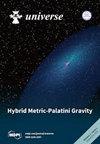具有反作用的黑洞扰动量子场论:I 总体框架
IF 2.6
4区 物理与天体物理
Q2 ASTRONOMY & ASTROPHYSICS
引用次数: 0
摘要
在一项开创性的工作中,霍金证明了经典时空中的自由量子物质场的自然态,解决了球对称真空爱因斯坦方程,是温度不等的KMS态。虽然霍金的计算不包括物质对几何的反作用,但相应的霍金辐射导致黑洞蒸发是完全有可能的,而黑洞蒸发原则上是可以观测到的。显然,要改进霍金的计算并将反作用包括在内,是一个量子引力问题。由于目前还没有公认的广义相对论量子场论,因此很难可靠地推导出反作用效应。一个显而易见的方法是使用质量固定的施瓦兹柴尔德黑洞的黑洞扰动理论,并将这些扰动量子化。然而,除了线性扰动之外,如何协调扰动理论与轨距不变性并不清楚。在最近的研究中,我们提出了一种解决这个问题的新方法,它适用于具有近似对称性的物理情形,如均质性(宇宙学)、球对称性(施瓦兹柴尔德)或轴对称性(克尔)。这个想法出人意料地可行,即首先构建完全量规不变观测变量的还原相空间的非微扰物理(还原)哈密顿,然后才根据观测变量直接应用微扰理论。这样,构建观测值的任务就与扰动理论分开了,从而可以明确地将扰动理论发展到任意阶。在本系列的第一篇论文中,我们概述并展示了针对球对称和爱因斯坦-克莱因-戈登-麦克斯韦理论二阶扰动的这一方法。对其他物质、对称性和更高阶的详细介绍和概括将出现在后续的配套论文中。本文章由计算机程序翻译,如有差异,请以英文原文为准。
Quantum Field Theory of Black Hole Perturbations with Backreaction: I General Framework
In a seminal work, Hawking showed that natural states for free quantum matter fields on classical spacetimes that solve the spherically symmetric vacuum Einstein equations are KMS states of non-vanishing temperature. Although Hawking’s calculation does not include the backreaction of matter on geometry, it is more than plausible that the corresponding Hawking radiation leads to black hole evaporation which is, in principle, observable. Obviously, an improvement of Hawking’s calculation including backreaction is a problem of quantum gravity. Since no commonly accepted quantum field theory of general relativity is available yet, it has been difficult to reliably derive the backreaction effect. An obvious approach is to use the black hole perturbation theory of a Schwarzschild black hole of fixed mass and to quantize those perturbations. However, it is not clear how to reconcile perturbation theory with gauge invariance beyond linear perturbations. In recent work, we proposed a new approach to this problem that applies when the physical situation has an approximate symmetry, such as homogeneity (cosmology), spherical symmetry (Schwarzschild), or axial symmetry (Kerr). The idea, which is surprisingly feasible, is to first construct the non-perturbative physical (reduced) Hamiltonian of the reduced phase space of fully gauge invariant observables and only then apply perturbation theory directly in terms of observables. The task to construct observables is then disentangled from perturbation theory, thus allowing to unambiguously develop perturbation theory to arbitrary orders. In this first paper of the series we outline and showcase this approach for spherical symmetry and second order in the perturbations for Einstein–Klein–Gordon–Maxwell theory. Details and generalizations to other matter and symmetry and higher orders will appear in subsequent companion papers.
求助全文
通过发布文献求助,成功后即可免费获取论文全文。
去求助
来源期刊

Universe
Physics and Astronomy-General Physics and Astronomy
CiteScore
4.30
自引率
17.20%
发文量
562
审稿时长
24.38 days
期刊介绍:
Universe (ISSN 2218-1997) is an international peer-reviewed open access journal focused on fundamental principles in physics. It publishes reviews, research papers, communications, conference reports and short notes. Our aim is to encourage scientists to publish their research results in as much detail as possible. There is no restriction on the length of the papers.
 求助内容:
求助内容: 应助结果提醒方式:
应助结果提醒方式:


